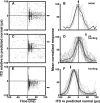Hunting increases adaptive auditory map plasticity in adult barn owls
- PMID: 16237185
- PMCID: PMC6725728
- DOI: 10.1523/JNEUROSCI.2533-05.2005
Hunting increases adaptive auditory map plasticity in adult barn owls
Abstract
The optic tectum (OT) of barn owls contains topographic maps of auditory and visual space. Barn owls reared with horizontally displacing prismatic spectacles (prisms) acquire a novel auditory space map in the OT that restores alignment with the prismatically displaced visual map. Although juvenile owls readily acquire alternative maps of auditory space as a result of experience, this plasticity is reduced greatly in adults. We tested whether hunting live prey, a natural and critically important behavior for barn owls, increases auditory map plasticity in adult owls. Two groups of naive adult owls were fit with prisms. The first group was fed dead mice during 10 weeks of prism experience, while the second group was required to hunt live prey for an identical period of time. When the owls hunted live prey, auditory maps shifted substantially farther (five times farther, on average) and the consistency of tuning curve shifts within each map increased. Only a short period of time in each day, during which the two groups experienced different conditions, accounts for this effect. In addition, increased map plasticity correlated with behavioral improvements in the owls' ability to strike and capture prey. These results indicate that the experience of hunting dramatically increases adult adaptive plasticity in this pathway.
Figures



References
Publication types
MeSH terms
Grants and funding
LinkOut - more resources
Full Text Sources
